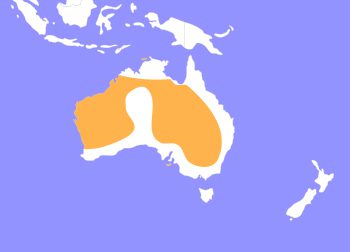Cockatiel
Nymphicus hollandicus
The cockatiel is a bird that is a member of its own branch of the cockatoo family endemic to Australia. They are prized as household pets, and companion parrots throughout the world. They have gained such popularity in part because they are relatively easy to breed. As a caged bird, cockatiels are second in popularity only to the budgerigar.
The cockatiel is the only member of the genus Nymphicus. It was previously considered a crested parrot or small cockatoo; however, more recent molecular studies have assigned it to its own subfamily, Nymphicinae. It is now classified as the smallest of the Cacatuidae (cockatoo family). Cockatiels are native to Australia, favouring the Australian wetlands, scrublands, and bushlands.
The cockatiel's distinctive erectile crest expresses the animal's emotional state. The crest is dramatically vertical when the cockatiel is startled or excited, gently oblique in its neutral in relaxed state, and flattened close to the head when the animal is angry or scared. The crest is also held flat but protrudes outward in the back when the cockatiel is trying to appear alluring or flirtatious. In contrast to most cockatoos, the cockatiel has long tail feathers roughly making up half of its total length. At 12 to 13 inches the cockatiel is the smallest of the cockatoos.

Cockatiels are year round residents to the continent of Australia.
HABITAT -They are native to Australia living in the wetlands, scrublands, and bushlands.
DIET -They are herbivorous, eating a variety of seeds, fruits, and vegetables.
FUN FACT -The cockatiel life span can reach up to 25 years, though the standard is 15 years.
SOCIAL BEHAVIOR -They are extremely social animals, living in flocks, they can also grow close attachments to their keepers.
ACTIVITY -They are diurnal being most active during the day and resting during the evening.
PREDATORS -Common predators of the cockatiel include birds of prey, such as hawks and eagles.
SIZE -The average size of an adult Cockatiel is 12 - 13 in, weighing about 3.2 oz.
RELATIVES -Cockatiels are a member of the parrot family, their closest relative is the Cockatoo.
CONSERVATION -Cockatiels are categorized as LC (Least Concern) by the IUCN.
Cub Creek Animal Care Information
Housing - We house our birds in one of our indoor flight enclosures.. Our enclosures are large rooms filled with trees! They are the newest renovation to the jungle building! Housing our birds in flight enclosures rather than small cages allows for more socialization and room to let their wings stretch! They have many branches all over the enclosure to perch on and fly to and fro. There is also a window where they can observe what is going on outside. Our cockatiels live with budgerigars and a dove as well as chinchillas.
Diet - These birds are fed ZuPreem small bird pellets, which includes everything they need to be healthy and receive all the necessary nutrients. They are also given bird salad, a mix of diced apples, shredded sweet potato, and chopped lettuce. Fresh water is given daily.
Enrichment - Their multi-species enclosure (with chinchillas and other bird species) provides enrichment through daily interactions and get to play with toys that are made for the others. Campers can use cardboard, twine, and pretty much anything we can find to make hanging toys that can have food hidden in them or just used to swing on!

